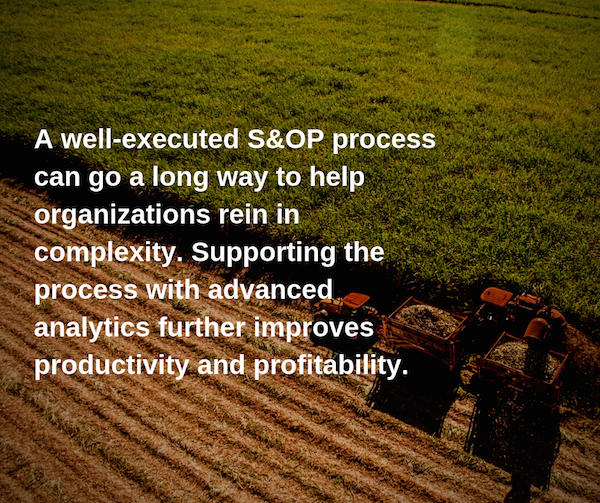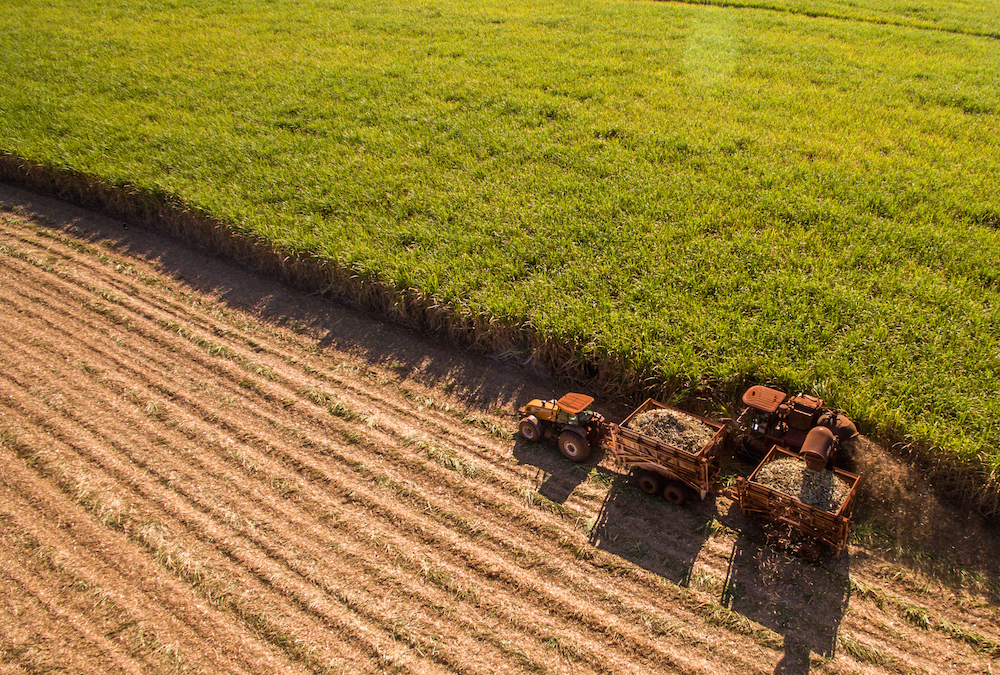S&OP in Agribusiness: How to Harvest the Benefits with Advanced Analytics
 The agribusiness supply chain is highly complex. It’s not limited to managing crops and livestock but encompasses all equipment, services, and product processing as well as commercialization. Besides the regular challenges expected of such an intricate operation, there are social and environmental concerns, stringent regulations, a labor shortage, and rising competition. These intricacies make planning and decision-making difficult.
The agribusiness supply chain is highly complex. It’s not limited to managing crops and livestock but encompasses all equipment, services, and product processing as well as commercialization. Besides the regular challenges expected of such an intricate operation, there are social and environmental concerns, stringent regulations, a labor shortage, and rising competition. These intricacies make planning and decision-making difficult.
A well-executed S&OP process can go a long way to help organizations rein in some of this complexity. However, supporting the process with advanced analytics goes even further, contributing to higher levels of productivity and profitability.
Insights from Tereos Sugar & Energy Brazil

In the past decades, Brazil has become a world leader in the agribusiness space. Tereos, the second biggest sugar producer worldwide, is an important stakeholder in this market, with 49 industry units in 4 continents. The company operates 7 sugar cane processing factories in Brazil, in a cluster located in the northwest region of Sao Paulo state. Like many organizations, Tereos recognizes the use of advanced analytics as an imperative. In a recent article published in Mundo Logística, Tereos’ Logistics and S&OP Executive Manager, André Margoto, shares valuable insights on how agribusiness companies can use optimization models in (near) real-time to inform planning decisions and bolster their S&OP process.
The article, written in collaboration with our partner Luciano Moura (UniSoma) and Diego de Carvalho Moretti (Nortegubisian), outlines the following planning challenges in an agribusiness supply chain:
- Supply chain flows are extended over a long period of time. There is an extensive horizon between the date of a supply decision (for instance, purchasing livestock feed or specific fertilizers) and its final result (the sale of the processed and packaged product).
- Raw material forecasting is difficult as climate conditions, pests, and other natural factors impact its availability. Many of these factors are difficult to control and predict.
- Forecasting demand for agribusiness products is also challenging. Commercialization is often Business-to-Business and Business-to-Consumer and product prices are intricately connected to international stock exchanges, climate conditions, and macro-economic indicators.
To ensure that the correct decisions are made in an agile way, considering all of these intricacies and trade-offs, companies should consider supporting the planning process with enabling technology.
Advanced analytics as enabling technology
Decision-making in agribusiness is still largely based on gut feel or empiricism. There is also a reliance on spreadsheets. But neither spreadsheets nor past experience provide enough fuel for a robust and integrated business planning process. Moreover, depending on the knowledge of the decision maker is a serious governance issue.
Planning cycles in this environment tend to be slow and often, when you reach a compromise on the plan, unexpected events force you to go back to the drawing board. Advanced analytics allow you to address the complexity of planning, focusing on one aspect of the chain or end-to-end while considering all the variables that influence decisions simultaneously. This increases the chances of finding opportunities that would be obscured when you only rely on human judgment or spreadsheets.
Advanced analytics can have two different applications in the S&OP process:
- Predictive analytics: to have the best possible projection of the relevant variables for decision-making (availability of raw material, future price levels, etc.);
- Prescriptive analytics: to define how and when to take action (production, stock, sales) in order to maximize the overall profitability of the business.
The use of predictive analytics is fairly common nowadays. While prescriptive analytics is not entirely new in the industry, advances in computing power have made it a lot more accessible in recent years. The entire supply chain can now be optimized in a model that prescribes which decisions should be taken (where to deliver the raw material, what to produce, where to stock, when and whom to sell), respecting all operational and commercial constraints as well as costs and prices, in order to maximize overall profitability.
Optimizers can quickly generate planning recommendations, enabling decision-makers to test a greater number of scenarios and possibilities. Suddenly, you can find appropriate responses to unexpected changes and analyze the impact on your bottom line.
Decision-making goes from a highly tedious and error-prone exercise to a process that combines computational intelligence with the business knowledge needed to analyze the optimizer’s results. A 5 percent to 10 percent increase in margin is common in the first year of implementation. The use of prescriptive analytics provides a modern and differentiated way of managing this process. But technology is only part of the process.
Decision-making goes from a highly tedious and error-prone exercise to a process that combines computational intelligence with the business knowledge needed to analyze the optimizer’s results. – Tweet this
People and culture are equally important
To successfully incorporate optimization into the business routine, you need the right people involved. The right mindset is equally important. Perhaps the greatest challenge in implementing a decision-making process supported by optimization is the cultural change required. The support of the business’s senior management is essential to support the initiative and incorporate the new way of working with the least resistance.
A harmonious way of working must be established among all sectors of the company, as per the strategy adopted. That is, after all, what S&OP (or IBP) is all about. It’s important to establish a governance process that points out the responsibilities and roles of each area in integrated supply chain planning. Providing training and education on the process and any enabling technology is necessary as well.
This approach may be challenging to embrace in several agribusiness segments, especially those that have yet to embrace new technologies and a culture of collaborative planning, but the benefits are well worth the effort.
Read our case study to find out how Tereos Sugar & Energy Brazil has improved its S&OP Process with optimization technology.





